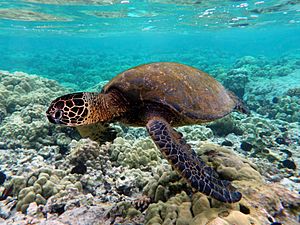Cheloniidae facts for kids
Quick facts for kids Cheloniid sea turtles |
|
|---|---|
 |
|
| A green sea turtle, a species of the family Cheloniidae, swimming over coral reefs in Kona, Hawaii | |
| Scientific classification |
|
| Kingdom: | Animalia |
| Phylum: | Chordata |
| Class: | Reptilia |
| Order: | Testudines |
| Suborder: | Cryptodira |
| Clade: | Pancheloniidae |
| Family: | Cheloniidae Oppel, 1811 |
| Type genus | |
| Chelonia Brongniart, 1800
|
|
| Genera | |
Cheloniidae is a group of large ocean turtles. They are known for their flat, smooth, and rounded shells. They also have strong, paddle-like front flippers. These flippers help them swim fast in the ocean. Unlike other turtles, their front flippers are stronger than their back ones. There are six main types of sea turtles in this family. These include the green sea turtle, loggerhead sea turtle, olive ridley sea turtle, hawksbill sea turtle, flatback sea turtle, and the Kemp's ridley sea turtle.
Contents
How are sea turtles built?
Sea turtles are different from their land relatives, the tortoises. Tortoises can pull their heads into their shells for safety. Sea turtles cannot do this. Their bottom shell, called the plastron, is also smaller. It connects to the top shell with flexible parts.
Sea turtles come in different sizes. They can be from about 71 to 213 centimeters long. For example, the Kemp's Ridley is one of the smaller ones. Its shell is about 75 centimeters long. It weighs around 50 kilograms. All sea turtles have a hard, strong shell.
How do sea turtles reproduce and grow?
Sea turtles have similar ways of reproducing. Female turtles come to sandy beaches to lay their eggs. They usually do this at night. They bury their eggs far from the ocean's high tide line. Most females lay eggs only once every three to four years. During a nesting season, which is from spring to late fall, they might lay eggs two to four times.
A common nest has about 100 eggs. The eggs usually take 50 to 60 days to hatch. How fast they hatch depends on the sand's temperature. Warmer sand makes the baby turtles hatch sooner. All the eggs in a nest tend to hatch at almost the same time. This helps the baby turtles dig their way out of the sand together. This usually happens at night. The temperature of the sand also affects if the baby turtles will be male or female. Warmer temperatures usually lead to more females. Colder temperatures tend to produce more males.
Where do sea turtles live and what do they eat?
Sea turtles live in many parts of the world. They prefer warm waters. You can find them in the tropical and subtropical areas of the Pacific and Atlantic Oceans. They also live in warmer seas like the Mediterranean Sea. When they are nesting, they stay near coastlines. Most of their lives are spent swimming over the continental shelf. This is where they find food.
Some olive ridley sea turtles travel very far. But most sea turtles stay in bays and estuaries. Most sea turtle species eat meat. They eat sea sponges, jellyfish, and small sea creatures. They also eat sea urchins and fish. The green sea turtle is different. When it's a baby, it eats meat. But as it grows, it becomes a plant-eater. Adult green sea turtles mainly eat different types of sea grasses.
Why are sea turtles important and what are their threats?
Many sea turtle species are in danger. Their conservation status can be endangered, threatened, or vulnerable. The green and loggerhead sea turtles are endangered. Olive ridley turtles are vulnerable. Kemp's ridley and hawksbill sea turtles are critically endangered. For the flatback sea turtle, there isn't enough information to know its exact status.
Many young sea turtles do not live long enough to have their own babies. They might be eaten by other animals. Or they might be caught by humans. This can happen on purpose or by accident in fishing nets. Sea turtles grow up slowly, often taking 10 to 15 years to become adults. This means many caught turtles haven't had a chance to reproduce yet. There are international laws to help protect them. However, some people still hunt them for their eggs or shells.
Sea turtles also face another big problem. It might be linked to human pollution. More and more turtles are getting a disease called fibropapillomatosis. This causes bumpy growths on their skin, mouths, and even inside their bodies. In some places, over 70% of turtles are infected. Scientists are still studying what this will mean for sea turtle populations in the future.
Sea turtles are very important for ocean ecosystems. They help keep sea grasses and coral reefs healthy. This helps other sea creatures like shrimp, lobsters, and tuna. Sea turtles are also the last living group of marine reptiles. They have been on Earth for at least 100 million years. They are also important in many cultures. People also enjoy seeing them in tourism. This makes their protection even more important.
What types of sea turtles are there?
Here are the main types of sea turtles alive today:
Carettinae Subfamily
- Genus Caretta
- Loggerhead sea turtle (Caretta caretta)
- Genus Lepidochelys
- Kemp's ridley sea turtle (Lepidochelys kempii)
- Olive ridley sea turtle (Lepidochelys olivacea)
Cheloniinae Subfamily
- Genus Chelonia
- Green sea turtle (Chelonia mydas)
- Genus Eretmochelys
- Hawksbill sea turtle (Eretmochelys imbricata)
- Genus Natator
- Flatback sea turtle (Natator depressus) (used to be in Chelonia)
Images for kids


